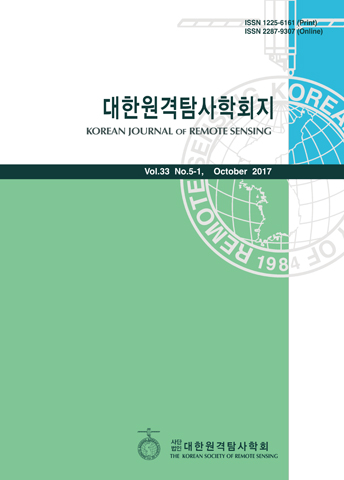화산재는 화산쇄설물 중 2 mm 이하의 크기를 가지는 작은 미세 암편으로 화산 분화 이후 낙하에 의해 여러 가지 피해를 가져온다. 화산재 피해는 운송업과 생산업 그리고 동·식물 및 인간의 호흡기 활동에 영향을 줄 수 있다. 따라서 이러한 화산재의 피해를 예방하기 위해서는 화산재 확산 정보가 중요하며 광범위하게 확산되는 화산재 관측은 위성을 활용하는 것이 효과적이다. 본 연구에서는 일본 사쿠라지마 화산의 두 번의 분화 사례를 연구하였으며 정지궤도 위성인 천리안 위성(Communication, Ocean and Meteorological Satellite: COMS)의 기상 탑재체(Meteorological Imager: MI) 영상과 극궤도 위성인 Landsat-8의 Operational Land Imager (OLI), Thermal InfraRed Sensor (TIRS) 영상을 활용하여 화산재 확산 정보를 산출하였다. COMSMI 영상으로부터 화산재 화소를 추출하여 화산재의 확산 방향과 속도를 분석하였으며, Landsat-8 영상에 대하여 그림자 측정법을 적용하여 화산재 높이를 산출하였다. 또한 본 연구에서 산출된 결과를 도쿄 화산재 주의보센터(Volcanic Ash Advisories center: VAAC)와 비교하였다. 비교 결과, 화산재 확산의 방향은 두 연구에서 모두 유사한 방향으로 산출되었으나 화산재 속도는 화산재주의보센터에서 제공되는 속도에 비해 약 4배 느리게 산출되었다. 또한, 화산재 높이는 화산재 주의보센터 정보에서는 단일 값으로 제공되지만 본 연구에서는 화산재 확산위치에 따라 다르게 관측됨을 확인하였다. VAAC의 경우 화산 분화의 빠른 대응을 위해 분화구 주변 지역에 대해 대략적 값을 산정하지만 본 연구에서는 화산재 확산이 중요하기 때문에 실제 화산재 확산이 관측된 다양한 영상으로부터 화산재가 확산된 전체 지역에 대한 정보를 산출하였기 때문에 차이가 발생하였을 것으로 판단된다. 대규모 분화가 발생할 경우 한반도에 미치는 영향을 확인하기 위해서는 화산재 확산 관측이 중요하다. 본 연구를 통해 서로 다른 특성을 지니는 위성영상을 활용하여 화산재가 확산된 전체 영역에 대해 다양한 정보를 산출하는데 활용될 수 있을 것이다.
Volcanic ash is a fine particle smaller than 2 mm in diameters. It falls after the volcanic eruption and causes various damages to transportation, manufacturing industry and respiration of living things. Therefore diffusion information of volcanic ash is highly significant for preventing the damages from it. It is advantageous to utilize satellites for observing the widely diffusing volcanic ash. In this study volcanic ash diffusion information about two eruptions of Mt. Sakurajima were calculated using the geostationary satellite, Communication, Ocean and Meteorological Satellite (COMS) Meteorological Imager (MI) and polar-orbiting satellite, Landsat-8 Operational Land Imager (OLI) and the Thermal InfraRed Sensor (TIRS). The direction and velocity of volcanic ash diffusion were analyzed by extracting the volcanic ash pixels from COMS-MI images and the height was retrieved by adjusting the shadow method to Landsat-8 images. In comparison between the results of this study and those of Volcanic Ash Advisories center (VAAC), the volcanic ash tend to diffuse the same direction in both case. However, the diffusion velocity was about four times slower than VAAC information. Moreover, VAAC only provide an ash height while our study produced a variety of height information with respect to ash diffusion. The reason for different results is measured location. In case of VAAC, they produced approximate ash information around volcano crater to rapid response, while we conducted an analysis of the ash diffusion whole area using ash observed images. It is important to measure ash diffusion when large-scale eruption occurs around the Korean peninsula. In this study, it can be used to produce various ash information about the ash diffusion area using different characteristics satellite images.




